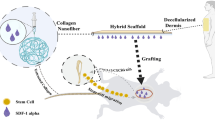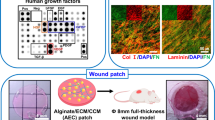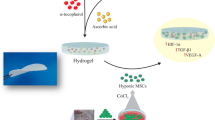Abstract
Stem cell transplantation is a promising therapy for wound healing, but the low retention and survival of transplanted stem cells limit their application. Injectable hydrogels exert beneficial effects in skin tissue engineering. In this study, an injectable hydrogel composed of sodium alginate (SA) and collagen type I (Col) was synthesized as a tissue scaffold to improve the efficacy of stem cells in a full-thickness excision wound model. Our results showed that SA/Col hydrogel was injectable, biodegradable, and exhibited low immunogenicity, which could promote the retention and survival of hUC-MSCs in vivo. SA/Col loaded with hUC-MSCs showed reduced wound size (p < 0.05). Histological and immunofluorescence results confirmed that SA/Col loaded with hUC-MSCs significantly promoted the formation of granulation, enhanced collagen deposition and angiogenesis, increased VEGF and TGF-β1 expression (p < 0.05), and mitigated inflammation evidenced by lower production of TNF-α and IL-1β and higher release of IL-4 and IL-10 (p < 0.05). Furthermore, SA/Col loaded with hUC-MSCs significantly lowered the expression of NLRP3 inflammasome-related proteins (p < 0.05). Taken together, our results suggest that SA/Col loaded with hUC-MSCs promotes skin wound healing via partly inhibiting NLRP3 pathway, which has potential to the treatment of skin wounds.








Similar content being viewed by others
Availability of data and materials
The data that support the findings of this study are available from the corresponding author upon request.
References
Agabalyan NA, Sparks HD, Tarraf S, Rosin NL, Anker K, Yoon G, Burnett LN, Nickerson D, Di Martino ES, Gabriel VA, Biernaskie J (2019) Adult human dermal progenitor cell transplantation modulates the functional outcome of split-thickness skin xenografts. Stem Cell Reports 13:1068–1082
Bian F, Xiao Y, Zaheer M, Volpe EA, Pflugfelder SC, Li DQ, de Paiva CS (2017) Inhibition of NLRP3 inflammasome pathway by butyrate improves corneal wound healing in corneal alkali burn. Int J Mol Sci 18:
Chappell JC, Wiley DM, Bautch VL (2012) How blood vessel networks are made and measured. Cells Tissues Organs 195:94–107
Chen B, Kao HK, Dong Z, Jiang Z, Guo L (2017) Complementary effects of negative-pressure wound therapy and pulsed radiofrequency energy on cutaneous wound healing in diabetic mice. Plast Reconstr Surg 139:105–117
Chen S, Shi J, Zhang M, Chen Y, Wang X, Zhang L, Tian Z, Yan Y, Li Q, Zhong W, Xing M, Zhang L, Zhang L (2015) Mesenchymal stem cell-laden anti-inflammatory hydrogel enhances diabetic wound healing. Sci Rep 5:18104
Chin JS, Madden L, Chew SY, Becker DL (2019) Drug therapies and delivery mechanisms to treat perturbed skin wound healing. Adv Drug Deliv Rev 149–150:2–18
Dong Y, A S, Rodrigues M, Li X, Kwon SH, Kosaric N, Khong S, Gao Y, Wang W, Gurtner GC (2017) Injectable and tunable gelatin hydrogels enhance stem cell retention and improve cutaneous wound healing. Adv Func Mater 27:1606619
Dvorak HF (2015) Tumors: Wounds that do not heal-redux. Cancer Immunol Res 3:1–11
Elliott EI, Sutterwala FS (2016) Monocytes take their own path to IL-1beta. Immunity 44:713–715
Gao X, Gao L, Groth T, Liu T, He D, Wang M, Gong F, Chu J, Zhao M (2019) Fabrication and properties of an injectable sodium alginate/PRP composite hydrogel as a potential cell carrier for cartilage repair. J Biomed Mater Res A 107:2076–2087
Geng X, Hong Q, Chi K, Wang S, Cai G, Wu D (2019) Mesenchymal stem cells loaded with gelatin microcryogels attenuate renal fibrosis. Biomed Res Int 2019:6749326
Gilarska A, Lewandowska-Lancucka J, Guzdek-Zajac K, Karewicz A, Horak W, Lach R, Wojcik K, Nowakowska M (2019) Bioactive yet antimicrobial structurally stable collagen/chitosan/lysine functionalized hyaluronic acid - based injectable hydrogels for potential bone tissue engineering applications. Int J Biol Macromol
Goren I, Christen U, Pfeilschifter J, Frank S (2018) A heterogeneous Ly-6B2(+) leukocyte population consists of yet undescribed iNOS-expressing cell types in murine skin wounds. Nitric Oxide 74:23–31
Griffin DR, Weaver WM, Scumpia PO, Di Carlo D, Segura T (2015) Accelerated wound healing by injectable microporous gel scaffolds assembled from annealed building blocks. Nat Mater 14:737–744
Guan F, Huang T, Wang X, Xing Q, Gumpper K, Li P, Song J, Tan T, Yang GL, Zang X, Zhang J, Wang Y, Yang Y, Liu Y, Zhang Y, Yang B, Ma J, Ma S (2019) The TRIM protein Mitsugumin 53 enhances survival and therapeutic efficacy of stem cells in murine traumatic brain injury. Stem Cell Res Ther 10:352
Hersant B, Sid-Ahmed M, Braud L, Jourdan M, Baba-Amer Y, Meningaud JP, Rodriguez AM (2019) Platelet-rich plasma improves the wound healing potential of mesenchymal stem cells through paracrine and metabolism alterations. Stem Cells Int 2019:1234263
Huang P, Wang L, Li Q, Xu J, Xu J, Xiong Y, Chen G, Qian H, Jin C, Yu Y, Liu J, Qian L, Yang Y (2019) Combinatorial treatment of acute myocardial infarction using stem cells and their derived exosomes resulted in improved heart performance. Stem Cell Res Ther 10:300
Kamoun EA, Kenawy E-RS, Tamer TM, El-Meligy MA, Mohy Eldin MS (2015) Poly (vinyl alcohol)-alginate physically crosslinked hydrogel membranes for wound dressing applications: Characterization and bio-evaluation. Arabian Journal of Chemistry 8:38–47
Kasuya A, Tokura Y (2014) Attempts to accelerate wound healing. J Dermatol Sci 76:169–172
Li T, Xia M, Gao Y, Chen Y, Xu Y (2015) Human umbilical cord mesenchymal stem cells: An overview of their potential in cell-based therapy. Expert Opin Biol Ther 15:1293–1306
Liang Y, Walczak P, Bulte JW (2013) The survival of engrafted neural stem cells within hyaluronic acid hydrogels. Biomaterials 34:5521–5529
Liu B, Ding F, Hu D, Zhou Y, Long C, Shen L, Zhang Y, Zhang D, Wei G (2018) Human umbilical cord mesenchymal stem cell conditioned medium attenuates renal fibrosis by reducing inflammation and epithelial-to-mesenchymal transition via the TLR4/NF-kappaB signaling pathway in vivo and in vitro. Stem Cell Res Ther 9:7
Liu X, Long X, Liu W, Zhao Y, Hayashi T, Yamato M, Mizuno K, Fujisaki H, Hattori S, Tashiro SI, Ogura T, Atsuzawa Y, Ikejima T (2018) Type I collagen induces mesenchymal cell differentiation into myofibroblasts through YAP-induced TGF-beta1 activation. Biochimie 150:110–130
Ma Z, Song W, He Y, Li H (2020) Multilayer injectable hydrogel system sequentially delivers bioactive substances for each wound healing stage. ACS Appl Mater Interfaces 12:29787–29806
Martin P (1997) Wound healing–aiming for perfect skin regeneration. Science 276:75–81
Marusina AI, Merleev AA, Luna JI, Olney L, Haigh NE, Yoon D, Guo C, Ovadia EM, Shimoda M, Luxardi G, Boddu S, Lal NN, Takada Y, Lam KS, Liu R, Isseroff RR, Le S, Nolta JA, Kloxin AM, Maverakis E (2020) Tunable hydrogels for mesenchymal stem cell delivery: Integrin-induced transcriptome alterations and hydrogel optimization for human wound healing. Stem Cells 38:231–245
Mushahary D, Spittler A, Kasper C, Weber V, Charwat V (2018) Isolation, cultivation, and characterization of human mesenchymal stem cells. Cytometry A 93:19–31
Nguyen NT, Nguyen LV, Tran NM, Nguyen DT, Nguyen TN, Tran HA, Dang NN, Vo TV, Nguyen TH (2019) The effect of oxidation degree and volume ratio of components on properties and applications of in situ cross-linking hydrogels based on chitosan and hyaluronic acid. Mater Sci Eng C Mater Biol Appl 103:109670
Rahimi M, Noruzi EB, Sheykhsaran E, Ebadi B, Kariminezhad Z, Molaparast M, Mehrabani MG, Mehramouz B, Yousefi M, Ahmadi R, Yousefi B, Ganbarov K, Kamounah FS, Shafiei-Irannejad V, Kafil HS (2020) Carbohydrate polymer-based silver nanocomposites: Recent progress in the antimicrobial wound dressings. Carbohydr Polym 231:115696
Rathinam VAK, Chan FK (2018) Inflammasome, inflammation, and tissue homeostasis. Trends Mol Med 24:304–318
Reynolds LE, Conti FJ, Lucas M, Grose R, Robinson S, Stone M, Saunders G, Dickson C, Hynes RO, Lacy-Hulbert A, Hodivala-Dilke K (2005) Accelerated re-epithelialization in beta3-integrin-deficient- mice is associated with enhanced TGF-beta1 signaling. Nat Med 11:167–174
Sakai S, Shichita T (2019) Inflammation and neural repair after ischemic brain injury. Neurochem Int 130:104316
Singer AJ, Clark RA (1999) Cutaneous wound healing. N Engl J Med 341:738–746
Spees JL, Lee RH, Gregory CA (2016) Mechanisms of mesenchymal stem/stromal cell function. Stem Cell Res Ther 7:125
Vallee A, Lecarpentier Y (2019) TGF-beta in fibrosis by acting as a conductor for contractile properties of myofibroblasts. Cell Biosci 9:98
Volz AC, Omengo B, Gehrke S, Kluger PJ (2019) Comparing the use of differentiated adipose-derived stem cells and mature adipocytes to model adipose tissue in vitro. Differentiation 110:19–28
Wang P, Huang S, Hu Z, Yang W, Lan Y, Zhu J, Hancharou A, Guo R, Tang B (2019) In situ formed anti-inflammatory hydrogel loading plasmid DNA encoding VEGF for burn wound healing. Acta Biomater 100:191–201
Wang X, Guan S, Zhang K, Li J (2020) Benlysta-loaded sodium alginate hydrogel and its selective functions in promoting skin cell growth and inhibiting inflammation. ACS Omega 5:10395–10400
Xu Q, A S, Gao Y, Guo L, Creagh-Flynn J, Zhou D, Greiser U, Dong Y, Wang F, Tai H, Liu W, Wang W, Wang W, (2018) A hybrid injectable hydrogel from hyperbranched PEG macromer as a stem cell delivery and retention platform for diabetic wound healing. Acta Biomater 75:63–74
Yao M, Zhang J, Gao F, Chen Y, Ma S, Zhang K, Liu H, Guan F (2019) New bmsc-laden gelatin hydrogel formed in situ by dual-enzymatic cross-linking accelerates dermal wound healing. ACS Omega 4:8334–8340
Zhang K, Shi Z, Zhou J, Xing Q, Ma S, Li Q, Zhang Y, Yao M, Wang X, Li Q, Li J, Guan F (2018) Potential application of an injectable hydrogel scaffold loaded with mesenchymal stem cells for treating traumatic brain injury. Journal of Materials Chemistry B 6:2982–2992
Zhao R, Liang H, Clarke E, Jackson C, Xue M (2016) Inflammation in Chronic Wounds. Int J Mol Sci 17:
Zhou J, Zhang K, Ma S, Liu T, Yao M, Li J, Wang X, Guan F (2019) Preparing an injectable hydrogel with sodium alginate and type I collagen to create better MSCs growth microenvironment. e-Polymers 19:87–91
Acknowledgments
We thank all the members of Prof. Fangxia Guan’s laboratory for the help and advice on this study.
Funding
This study was supported by Key R&D and Promotion Projects in Henan Province (202102310211), Central Plains Thousand People Plan of Henan Province (204200510013), Training plan for young excellent teachers in Colleges and Universities of Henan (2020GGJS008), and Joint Fund for Fostering Talents of NCIR-MMT & HNKL-MMT (No. MMT2017-04).
Author information
Authors and Affiliations
Contributions
SS.M and FX.G conceived and designed the experiments. ZK.Z and SS.M wrote the manuscript. K.Z and MH.Y revised the final version of the paper. ZK.Z, Z.L and Y.L performed the experiments. YY.W, ZY.C, H.Y, and JJ.S prepared materials and analyzed the data. All authors reviewed the manuscript prior to submission.
Corresponding author
Ethics declarations
Ethical approval
This study was approved by the Ethics Committees of the Zhengzhou University. All procedures involving human participants were conducted in accordance with the ethical standards of the Ethics Committees of the First Affiliated Hospital of Zhengzhou University. All the animal procedures were conducted in strict accordance with the National Institutes of Health guidelines for the Care and Use of Laboratory Animals.
Conflict of interest
The authors declare that they have no conflict of interest.
Informed consent
All applicable international, national, and/or institutional guidelines for the care and use of animals were followed. This study was approved by the Ethics Committees of the Zhengzhou University. All procedures involving human participants were conducted in accordance with the ethical standards of the Ethics Committees of the First Affiliated Hospital of Zhengzhou University. The human umbilical cords were obtained from healthy donors following full-term cesarean with prior informed consent.
Rights and permissions
About this article
Cite this article
Zhang, Z., Li, Z., Li, Y. et al. Sodium alginate/collagen hydrogel loaded with human umbilical cord mesenchymal stem cells promotes wound healing and skin remodeling. Cell Tissue Res 383, 809–821 (2021). https://doi.org/10.1007/s00441-020-03321-7
Received:
Accepted:
Published:
Issue Date:
DOI: https://doi.org/10.1007/s00441-020-03321-7




